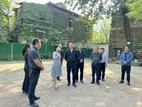Rev. Charles Rogers Mills of Guilford, New York, arrived in Shanghai with his wife in February 1857. Along with them were the Gayleys: Rev. Samuel R. Gayley, his wife and his sister. Because the Mills could not adapt to the climate of Shanghai, they moved to Dengzhou in July, 1862. Mills had been the head of the Dengzhou Presbyterian Mission from 1865 until his death in 1895.
Upon Mills' arrival and the later arrival of Rev. Hunter Corbett and Rev. Calvin Wilson Mateer, they gradually got on with the local people. As the local people started to understand their respective characters and styles of doing things, they gave them nicknames. Rev. Mills was a man of modesty and respect, thin and slender, so people gave him the nickname, "eight-horned plum deer."
During the 34 years of living in Dengzhou, he made an important contribution to the steady and healthy development of the region's church because of his humility and courtesy, both towards his colleagues and the missionaries of the Dengzhou Baptist Church. Although he was not directly involved in the establishment of schools, as the head of the Dengzhou Presbyterian Mission, he was fully supportive of the establishment of the new types of schools.
During his time in Dengzhou, in addition to paying attention to the strengths of all the people within the Presbyterian Church and promoting the smooth development of the cause of the Presbyterian Church, he and his second wife founded China's first school for the deaf and mute. Dengzhou Qiyin School, the very first example of introducing western, modern, special education to China. They successfully introduced and promoted the cultivation of the large American peanut, making important contributions to the commerce of the rural economy and agricultural production in Shandong and in the whole country.
Mills had seven children from his first wife. The first two sons caught cholera and died prematurely in Dengzhou in 1862 while on a ship from Shanghai to Yantai and on the journey from Yantai to Dengzhou. Among the four children born and raised in Dengzhou, one of them was deaf. In 1874, Mrs. Mills died of illness, and the responsibility of caring for the four children fell on Rev. Mills' shoulders. There was no deaf education in China at that time, and in 1879, Mills sent his deaf child to a school in Rochester, New York, for special education. In this sense, it can be said that the Qiyin School in Dengzhou was the "natural result of the pain suffered by his own son".
Annette E. Thompson, a teacher at the Rochester School in New York, had been teaching there for several years before Mills sent her son there to study. In some of the commemorative articles written by her at the time, Ms. Thompson greatly admired Mills' identity, character, and especially his religious devotion. She went to Dengzhou, Shandong in 1884, and in the same year, married Mills. Later she was given the Chinese name, Mei Naide. In 1887, the couple founded the Qiyin School in Dengzhou.
Although the Mills started to set up the school for special education, it was difficult, because there was no such special school in all of China at the time, not to mention most common people not being able to afford to go to school, let alone caring to send deaf children to school. In order to attract people to send deaf and mute children to receive education, Dengzhou Qiyin School not only provided free education, but also provided free clothing, food, and medical care. Despite this, only four students attended in the nine-year period of the school's operation. In 1895, after Rev. Mills died, the Presbyterian Church stopped providing funds, and the school was closed. In order to resume running it, Mrs. Mills, despite the pain of losing her husband, travelled widely to seek help. The first result was the Rochester School's promise to fund a year's trial running the school on the condition that Mrs. Mills would stop missionary work. She then received funding and donated equipment from "deaf and mute people in the United States, as well as other American and British friends".
In view of the lack of transportation at the time, Mrs. Mills moved to Yantai in 1898 and began renting a house in order to restore the School. After many efforts, she finally gained a foothold and invited her niece, Anita E. Carter, who worked for the U.S. Department of Health, to help run the school. It eventually grew to a certain level. During the time before and after the Revolution of 1911, which was led by Dr. Sun Yat-sen (1911-1912), more than 50 people from throughout the country had been enrolled while also training special education teachers for all parts of the country. From then until before the Anti-Japanese War broke out, Mrs. Mills' ministry trained a large number of teachers for all parts of the country and also for Korea. This lead to and helped establish more than a dozen schools for the deaf and mute, and became the veritable center of education for the deaf and mute amongst Chinese.
After his death, Rev. Mills was buried in Penglai. His tombstone, located in Penglai Baxiandu, is inscripted in both Chinese and English.
(The article was originally published in the Sina blog of Donghaisanxian.)
- Translated by Charlie Li












